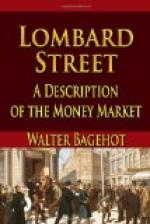By the law of England the legal tenders are gold and silver coin (the last for small amounts only), and Bank of England notes. But the number of our attainable bank notes is not, like American ‘greenbacks,’ dependent on the will of the State; it is limited by the provisions of the Act of 1844. That Act separates the Bank of England into two halves. The Issue Department only issues notes, and can only issue 15,000,000 L. on Government securities; for all the rest it must have bullion deposited. Take, for example an account, which may be considered an average specimen of those of the last few years—that for the last week of 1869:
An account pursuant to the Act 7th and 8th Victoria, cap. 32, for the week ending on Wednesday, the 29th day of December, 1869.
Issue department.
Notes issued 33,288,640 L Government debt 11,015,100
L
Other
securities 3,984,900 L
Gold
coin and bullion 18,288,640 L
Silver
bullion
33,288,640
33,288,640 L
Banking department.
Proprietors’ capital 14,553,000 L Government
Securities 13,811,953 L
Rest 3,103,301 L Other securities
19,781,988 L
Public deposits, Notes
10,389,690 L
including Exchequer, Gold and silver
coins 907,982 L
Savings’ Banks,
Commissioners of
National Debt,
and dividend
accounts 8,585,215 L
Other deposits 18,204,607 L
Seven-day and other
bills 445,490 L
44,891,613
L 44,891,613 L
GEO. Forbes, Chief Cashier.
Dated the 30th December, 1869.
There are here 15,000,000 L. bank notes issued on securities, and 18,288,640 L. represented by bullion. The Bank of England has no power by law to increase the currency in any other manner. It holds the stipulated amount of securities, and for all the rest it must have bullion. This is the ‘cast iron’ systemthe ‘hard and fast’ line which the opponents of the Act say ruins us, and which the partizans of the Act say saves us. But I have nothing to do with its expediency here. All which is to my purpose is that our paper ’legal tender,’ our bank notes, can only be obtained in this manner. If, therefore, an English banker retains a sum of Bank of England notes or coin in due proportion to his liabilities, he has a sufficient amount of the legal tender of this country, and he need not think of anything more.
But here a distinction must be made. It is to be observed that properly speaking we should not include in the ‘reserve’ of a bank ‘legal tenders,’ or cash, which the Bank keeps to transact its daily business. That is as much a part of its daily stock-in-trade as its desks or offices; or at any rate, whatever words we may choose to use, we must carefully distinguish between this cash in the till which is wanted every day, and the safety-fund, as we may call it, the special reserve held by the bank to meet extraordinary and unfrequent demands.




